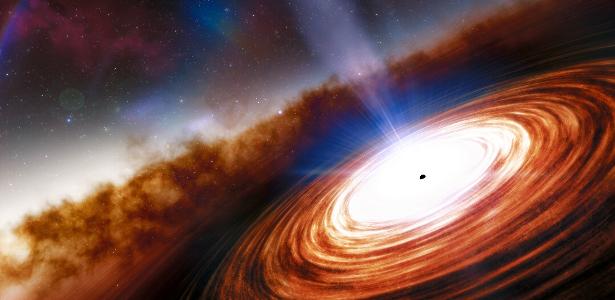
More science, more observations, another broken record. That week, an international team of astronomers, with the presence of scientists from the United States, Europe and China, announced the discovery of the quasar J0313-1806, the furthest ever visited.
Quasars are supermassive black holes, surrounded by a disk of matter that glows brightly.
The measurements of J0313-1806 are impressive: the black hole has a mass of more than one billion suns and shines with an intensity of more than 30 trillion stars. To give you an idea, our entire galaxy, the quasar alone is a thousand times brighter than the Milky Way!
Of course, the farther away an object, the weaker the brightness we observe. In this case, at a distance of about 30 billion light years, the challenge was enormous.
The object was first seen in combination with images from various telescopes on the planet and had properties that indicated the properties of a distant quasar.
To confirm the suspicion, the team used a new combination of telescopes (and even Alma Radio Telescope Antennas), This time to measure the speed of removal of the quasar.
Relative to our knowledge of the expansion of the universe, scientists were then able to determine distances in quasars, confirming the new champion, breaking the previous record by about 100 million light years.
Challenge for theoretical models
We might think that only the largest and brightest quasars would be observable at such a distance, after all, the weakest objects are invisible even to our most sensitive instruments.
However, the existence of J0313–1806 is already a challenge to our understanding of the creation of these cosmic monsters. After all, keeping in mind the time it took for its light to reach us, we are looking at an object that existed at a time when the universe was only 670 million years old.
Again, the mystery concerns the pace of its development. How can a black hole with more than one billion solar masses reach in such a short time?
According to the study’s leader, Feiye Wang, “black holes created by the first stars in the universe could not have grown so much in just a few hundred million years”.
Thus, an alternative theory is needed, something that probably produces black holes directly from the collapse of gas clouds at the beginning of the universe, not from the death of stars.
The study also revealed that the growth of a black hole should be related to the growth of its host galaxy. Eventually, this galaxy produces new stars at an accelerated rate of 200 new stars a year.
Thus, this new discovery presents a great opportunity for scientists around the world to study the joint evolution process of the first black holes and first galaxies in the universe. get to work!



